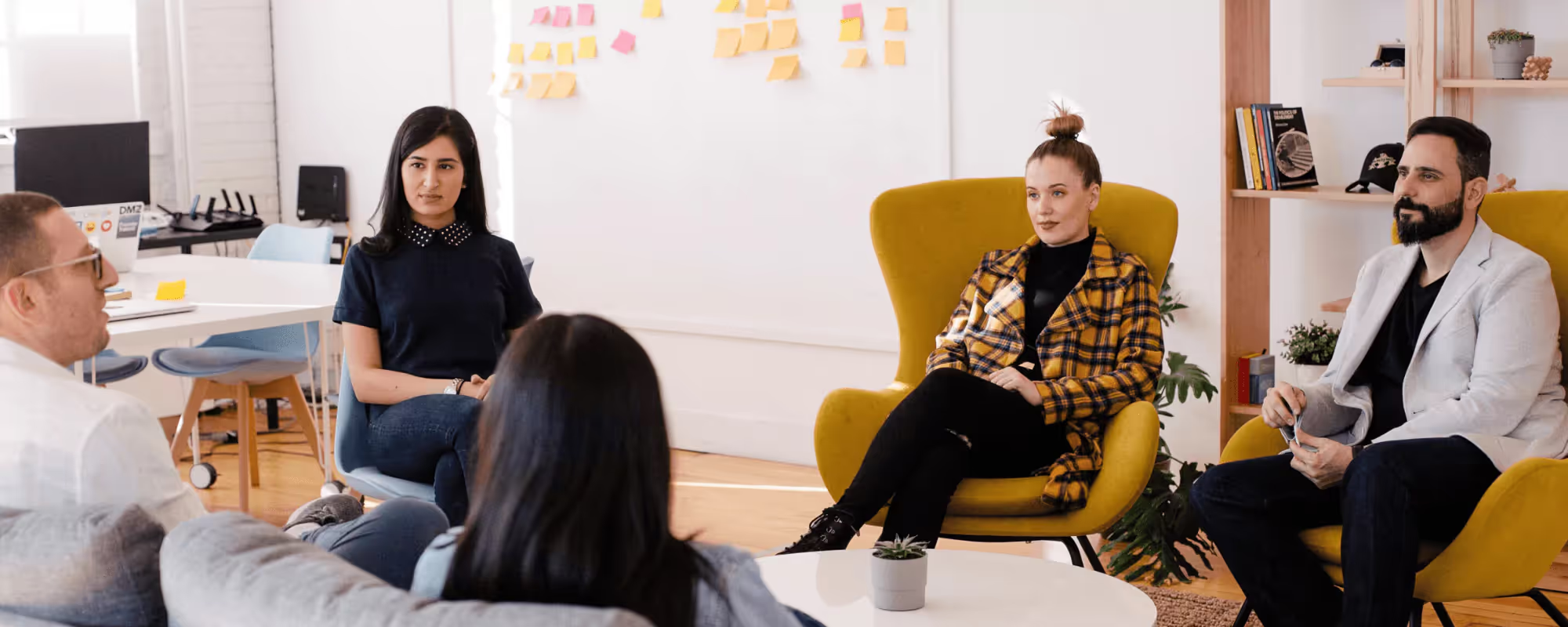As a Customer Experience (CX) & User Experience (UX) Consultant, facilitation is one of my favorite aspects of my work.
At Highland, most of our projects start with research as a business strategy to help us better understand our client’s target customer (read: the real user / end user of a product or service). A crucial part of that research process — before we can move into designing and building products — is testing product concepts using Google Venture’s design sprint format (created by Jake Knapp).
What is design sprint facilitation?
Design sprints are a phenomenal tool for quickly learning and brainstorming what metrics stakeholders and customers value without making a massive investment in building or launching a product. But here’s the catch: in order to be successful in the design sprint process — or any working session — you MUST have a strong facilitator.

If you’re interested in growing as a facilitator professionally or personally, I strongly recommend Priya Parker’s book, The Art of Gathering. Their human-centred approach to facilitation is a game-changer.
Building off my experience, I’ve created a template for my best tips and hacks for great facilitation. These insights focus on group workshop sessions, but I hope they help you with any facilitating you do — from design sprints to dinner parties. Running a design sprint can be hard work, but these tips should make it easier and more fun too.
What are the best practices for design sprint facilitation?
Great facilitation boils down to two guiding principles: clarity and energy. Here, we’ll dive deeper into these principles of clarity and energy, and share expert facilitator’s top tips.
Clarity: don’t be a chill host
Priya Parker argues that the main downfall of gatherings is when we try to be “chill” while leading groups when, in fact, people want to be led with clarity. Great facilitators clearly understand the purpose of their gathering before their guests or participants arrive, and then intentionally structure the gathering to meet that goal.
Get clear on your ‘why’ and the rest will follow
Knowing your why is essential — it’s the building block of great facilitation. Ask yourself what your why is before you start your sprint. Then ask yourself why again and again throughout the design sprint process.
Your why is usually different from your sprint goal. In design sprints, a sprint goal helps us create a shared long-term goal and vision for a new product or service. But our why is really about learning and alignment.
Testing a prototype during a product design sprint isn’t about proving an idea is good in order to meet our sprint goal; it’s about learning what customers think, regardless of whether they love it or hate it. The conversations that happen in the three days leading up to prototyping are just as important as the results of your user testing. These are the moments when disparate sprint team members begin to align and get validation around a shared sense of why. It’s when you get their buy-in. This step-by-step alignment helps your sprint participants learn from one another’s perspectives, solve problems and move the group forward more cohesively.
Goals keep us grounded on what we’ve set out to do. The why shapes how you facilitate and the definition of success.
“By having a clearly identified purpose for the event, participants will have more chances to actually connect, and not be disappointed.”
Know when to shut the door
Once you’re clear on your why, it’s time to think about who should be in the room. The more purposeful your group, the more progress towards your long-term goal you’ll make in your sprint.
You want a diverse group of no more than 8 people. Any time I’ve surpassed that number in a design sprint, I’ve regretted it.
You might be thinking: Really? But what if I have 10 people in mind?
Sprints move so quickly that adding even one more person can make it more difficult to hear everyone’s perspective. It hampers decision-making (competing with the goal of alignment) and it’s harder to fit all the deliverables in the timeline (competing with the goal of learning).
“Gatherings that please everyone occur, but they rarely thrill. Gatherings that are willing to be alienating — which is different from being alienating — have a better chance to dazzle.”
Help participants step out of their comfort zones in order to connect
After reading Parker’s book, I ask myself the following question before facilitating a workshop or event:
“Are there any obvious or hidden barriers to the group connecting meaningfully and achieving the purpose of our gathering?”
Some barriers and big challenges I’ve encountered include:
- product managers, UX designers and design sprint teams getting distracted by technology and functionality
- individuals isolating themselves by talking about kids/work
- multiple conversations happening in tandem rather than focusing in as a group. This can be even more difficult if you are running a remote design sprint where people aren't in the same room as you.
By anticipating these barriers, I’m able to identify them when they arise and come up with creative ways to deviate away from them and conserve valuable time.
The next time you’re facilitating a group, try incorporating a purposeful rule with a playful consequence. Let me share a case study example with you. Once when I was facilitating a branding workshop, I asked the group to describe their internal team. The group had a tendency to describe their company by simply saying, “We’re awesome!” While this is a wonderful way to feel about your team, it was too ambiguous an answer to help us achieve our why of uncovering the authentic brand identity and storyboard for the company. I wanted the group to go deeper and brainstorm more effectively. I established a rule that if anyone used the word awesome, they had to stand up and spin around three times. This rule helped force the team to find new words to describe themselves and get clearer on their brand.
Take the lead — or someone else will
People want to be led, whether they admit it or not. If you try to be a “chill” host, someone else will inevitably step in to fill that leadership gap. This can be a big problem as the loudest voice or biggest personality will default as the group leader, and will likely derail your gathering.
Instead, accept the workshop facilitator torch and take charge. How might we do this (known as HMW)? Be friendly but firm. It may feel uncomfortable at first, but I promise people will welcome your leadership. The facilitator needs to become the MVP of the room to ensure that the design thinking stays on track from day one.
If you don’t take the lead, the loudest person with the biggest personality will take control of the meeting and the design sprint.
Energy: mind the moment
Great facilitators are always mindful of the energy dynamics in the group. By helping to set a tone of trust, you make it easier for your participants to connect.
Set the right tone and the group will follow
Great facilitators know how to carry themselves and speak in a way that sets the right tone for the group. Our words and — maybe most importantly — our non-verbals signal to the group what to expect and what’s acceptable. Here are some best practices:
- Don’t open with logistics. Instead, prioritize connection from the start
- Open with warm introductions. They’ll help the group see each other and connect
- Avoid turning your back on the group when you’re talking; face them rather than just the whiteboard and post-it sticky notes
- As you lead, affirm and encourage. Look people in the eye. Smile. Move around. Lean in.
Prioritize honesty over performing your “best self"
Priya Parker advocates that facilitation is ultimately about helping people have the conversations they aren’t currently having but need to have in order to succeed.
Even before the gathering starts, tell the group what you’re explicitly expecting of them. Invite them to be courageous and honest; affirm them accordingly. Consider grouping ideas, such as a process for each sprint week.
As the facilitator, you can set the tone by admitting when you’re feeling stuck or anxious and inviting the group to engage. Chances are they’re feeling that way as well and will be relieved to hear it’s not just them.
Protect the group experience
Be mindful of the physical, emotional, and relational wellbeing of the group.
- If energy seems to be lagging, take a break. Encourage people to get up and move around. Have healthy snacks and drinks available. Speak rather than relying on the whiteboard.
- If you sense some anxiety — which is to be expected— normalize it! If something’s confusing or frustrating, name it! These emotions are normal; naming them will allow people to relax and embrace it.
- If someone’s being particularly disruptive or difficult — especially during design sprints — positively affirm and redirect them. Some phrases I’ve used are “include that idea in your solution sketch” or “I’ll capture that, but for the sake of time we’ll need to move ahead.” If necessary, take them aside and ask them to trust the process. “I really value your contribution, and for this to be successful, I need you to…”
Embrace the end of your time together
Just as you opened with warm connection, end with a sense of gratitude for the trust you’ve built.
“Too many of our gatherings don’t end, they simply stop.”
How a design sprint methodology works
As a part of your design sprint methodology, claim your ending and make it purposeful. How you end shapes the group memory and sense of meaning. Help them look inward and turn outward — reflecting on the experience and taking what’s important back to their world.
Just as you don’t open with logistics on the first day, don’t end with logistics.
Intentional endings can be as simple as walking a guest to the door rather than letting them see themselves out, or having everyone look each other in the eye, raise a glass, and say cheers!
Now that you know what it takes to be a great facilitator, it’s time to practice
Learning to be a great facilitator takes experience. The more you realize facilitation is ultimately about helping people connect, validate and have conversations, the easier it is to design and lead experiences that matter and answer both business questions and team questions. Thought leaders like Priya Parker and the folks at Google Ventures can be great guides for shaping your own style of facilitation.
Cheers to you, my fellow facilitators! Now, go shake things up and get people talking!
How Highland can help with your design sprint process
With a firm focus on human-centred design, we create concepts, products and experiences your customers will love. From start-ups to large scale international companies, find out how Highland can help you with your design sprint workshops today.
Download “The Essential Guide to Launching a Digital Product for Experts & Expert Firms”



